Did you know that over 2,000 native plant species call New Jersey home, yet most homeowners plant less than 10% natives in their landscapes? You’re missing out on incredibly resilient plants that’ll thrive with minimal care while supporting local ecosystems. These hardy natives have survived ice ages, droughts, and everything nature’s thrown at them for millennia. The secret lies in understanding which species match your specific soil conditions and microclimates.
Contents
- 1 Northern New Jersey’s Soil Types
- 2 Best Native Wildflowers
- 3 Native Canopy Trees
- 4 Native Understory Shrubs
- 5 Selecting the Right Native Plants for Your Garden
- 6 Frequently Asked Questions
- 6.1 When Is the Best Time to Plant Native Species in Northern New Jersey?
- 6.2 How Do I Control Invasive Species That Compete With My Native Plants?
- 6.3 What Native Plants Attract Butterflies and Hummingbirds to My Garden?
- 6.4 Do Native Plants Require Fertilizer or Can They Grow Without Amendments?
- 6.5 Where Can I Purchase Native Plants and Seeds in Northern New Jersey?
Northern New Jersey’s Soil Types
Understanding your soil transforms gardening from guesswork to science, especially in northern New Jersey where glacial history created a complex patchwork of earth beneath your feet. You’ll encounter five main soil series here, each with distinct personalities.
The Booton Series dominates Passaic County’s uplands, where glacial till characteristics include rocky, acidic conditions from shale and basalt parent materials. Rockaway soils offer brown, gravelly loam across multiple counties. Dunellen develops on outwash plains, particularly along the Saddle River.
Soil acidity impacts plant selection considerably—most northern New Jersey soils lean acidic, favoring native species adapted to these conditions over alkaline-loving imports. The soil profile consists of distinct layers including the A Horizon topsoil that’s rich in organic material and essential for supporting your plants’ root systems.
Best Native Wildflowers
Native wildflowers thrive in Northern New Jersey’s climate while supporting local ecosystems. Key considerations include species diversity, ecological benefits, seasonal blooming patterns, climate adaptations, and popular varieties for landscaping. Several species like Eastern Columbine bloom in late spring, providing beautiful displays for gardeners and essential resources for pollinators.
Wild Bergamot (Monarda Fistulosa)

Wild Bergamot is a hardy native perennial that reaches 2-5 feet tall with aromatic, gray-green foliage and distinctive ragged pompom flowers in lavender, pink, or white. This widespread North American native blooms from June through September, providing essential late-season nectar for bees, butterflies, and hummingbirds. Its minty-scented leaves have traditional medicinal uses, and the plant spreads via rhizomes to form attractive clumps. The edible flowers can be used as a colorful garnish for salads and desserts.
This versatile wildflower thrives in naturalized meadows, native plant gardens, and herb borders while being resistant to deer and rabbits. Wild Bergamot tolerates various conditions including black walnut proximity, making it valuable for mixed plantings and pollinator support.
- Hardiness: Hardy perennial well-suited to northern New Jersey’s climate and temperature fluctuations
- Light: Full sun preferred, tolerates partial shade
- Water: Moderate water needs; tolerates drought but performs best with consistent moisture
- Soil: Well-drained soils preferred, especially limy soils; avoid overly wet or compacted conditions
- Fertilizer: Low fertilizer requirements as a native plant
- Pest/Disease Resistance: Susceptible to powdery mildew and rust, especially when stressed or overcrowded; deer and rabbit resistant
- Growth Rate: Moderate growth rate, spreading via rhizomes to form clumps
New England Aster
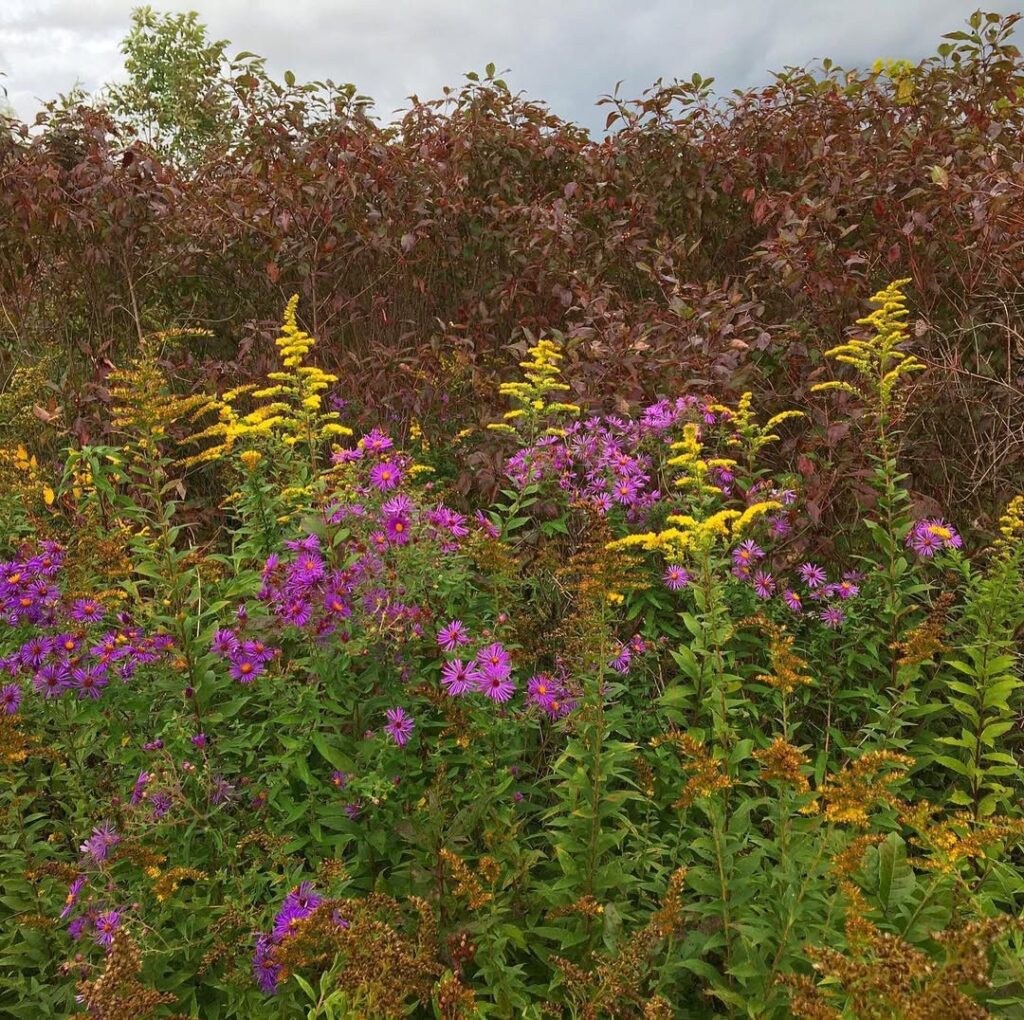
New England Aster is a stunning native perennial that forms sturdy clumps 3-4 feet tall and wide. This quintessential fall wildflower produces showy panicles of purple, pink, or white flowers with bright yellow centers that bloom for months. Native to Eastern North America, it thrives in moist sites from marshlands to garden borders.
As a late-season pollinator magnet, New England Aster attracts Monarch butterflies, skippers, and bees when few other flowers remain. Its smooth, lance-shaped gray-green leaves and long-lasting blooms make it an excellent choice for fall color displays alongside goldenrods and native grasses. To promote stronger growth and prevent flopping, consider pruning back stems to 6 inches early in the growing season.
- Hardiness: USDA zones 3-9
- Light: Full sun
- Water: Medium to high moisture; adaptable to moist sites
- Soil: Well-drained sandy, loamy, or clay soils
- Fertilizer: Low maintenance; minimal fertilization needed
- Pest/Disease Resistance: Generally resistant with few serious issues
- Growth Rate: Moderate; forms clumps through spreading
Wild Columbine (Aquilegia Canadensis)
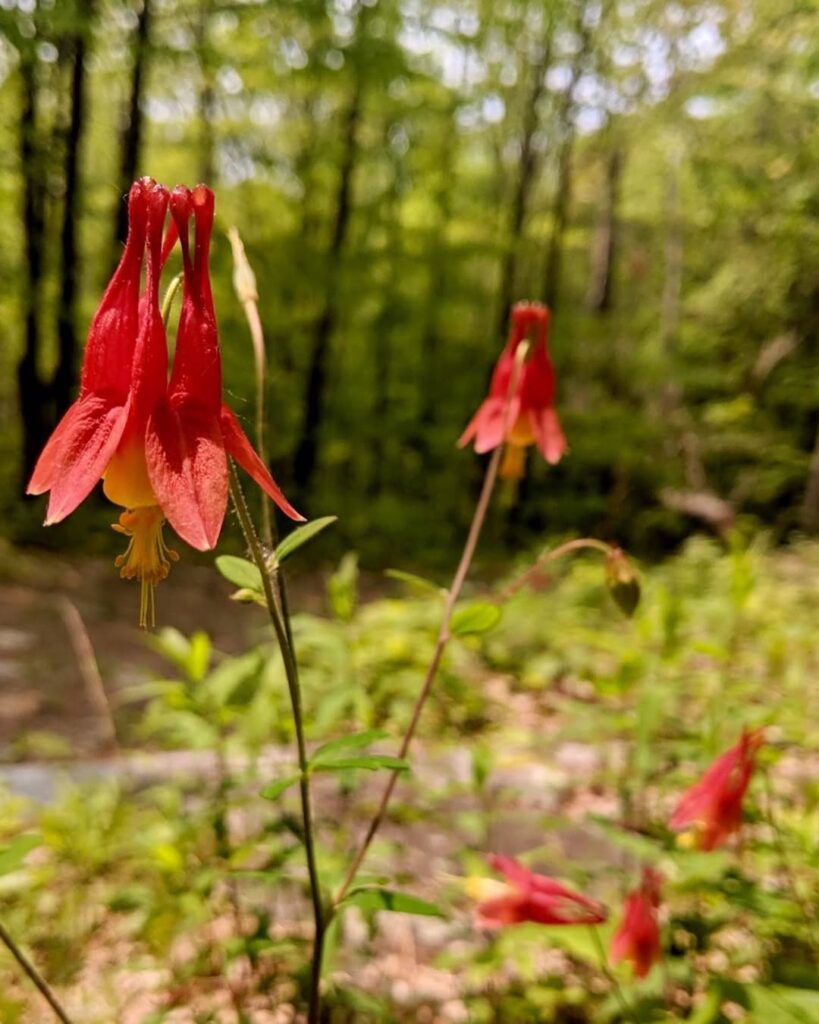
Wild Columbine is a charming native wildflower featuring distinctive nodding, bell-shaped blooms in striking red and yellow combinations. Growing 1-3 feet tall, this graceful perennial produces intricate flowers with red sepals and yellow petals, complemented by prominent red spurs that extend 20-25 mm from each bloom. The delicate, glaucous foliage provides an elegant backdrop for the May through June flowering display.
This versatile native thrives in woodland settings, rocky slopes, and well-drained soils throughout eastern North America. Wild Columbine readily self-seeds under favorable conditions, making it excellent for naturalizing in shade gardens, rock gardens, and cottage garden settings. Its deep nectaries attract hummingbirds and long-tongued pollinators, while its natural deer resistance adds to its garden appeal. The plant produces tan follicles as its fruit type, typically developing after the flowering period concludes.
- Hardiness: USDA zones 3-8
- Light: Full sun to full shade; performs well in partial shade
- Water: Moist to mesic conditions; tolerates dry conditions once established
- Soil: Well-drained loam, sand, or rocky substrates; thrives in thin soils over limestone, granite, or quartzite
- Fertilizer: Performs poorly in overly rich soils; avoid heavy fertilization
- Pest/Disease Resistance: Deer resistant; generally pest and disease free
- Growth Rate: Moderate; self-seeds readily for natural establishment
Wild Lupine (Lupinus Perennis)

Wild Lupine is a stunning native perennial that produces distinctive blue to purple flower spikes in late spring through early summer. Growing 1-2 feet tall with palmately compound leaves and hairy stems, this member of the bean family is perfectly adapted to northern New Jersey’s sandy soils and woodland edges.
Beyond its ornamental value, Wild Lupine serves as the exclusive larval host plant for the federally endangered Karner blue butterfly while supporting numerous pollinators. As a legume, it fixes atmospheric nitrogen, naturally enriching poor soils. This makes it invaluable for restoration projects and wildlife gardens, though declining populations due to habitat loss emphasize the importance of including it in native plantings. The plant’s palmately compound leaves are divided into 7-11 leaflets, creating an attractive foliage display even when not in bloom.
- Hardiness: Perennial in northern New Jersey, returning reliably each year
- Light: Full sun preferred, tolerates partial shade along woodland edges
- Water: Drought tolerant once established, prefers well-drained conditions
- Soil: Sandy, well-drained soils; thrives in nutrient-poor conditions
- Fertilizer: None needed due to nitrogen-fixing ability
- Pest/Disease Resistance: Susceptible to powdery mildew and root rot in poorly drained soils
- Growth Rate: Moderate, establishes well in disturbed or naturalized areas
Purple Coneflower (Echinacea Purpurea)
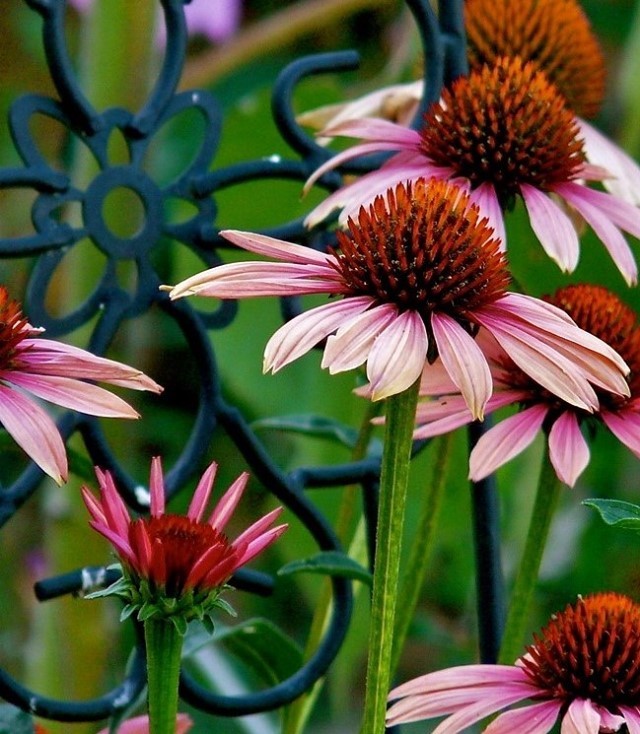
Purple Coneflower is a beloved native perennial that brings reliable color and ecological value to northern New Jersey gardens. This hardy wildflower produces striking lavender-purple blooms with distinctive spiny centers from late spring through early fall, attracting butterflies, bees, and other beneficial pollinators throughout its extended flowering period.
Growing 2-4 feet tall with rough-textured foliage, Purple Coneflower thrives in various garden settings from formal borders to naturalized meadows. Its exceptional drought tolerance, deer resistance, and low maintenance requirements make it an ideal choice for sustainable landscaping, while its seeds provide valuable winter food for birds when flower heads are left standing. Beyond ornamental value, Purple Coneflower extracts are thought to improve white blood count and act as a mild natural antibiotic.
- Hardiness: Zones 3-8, excellent cold tolerance and heat resistance
- Light: Full sun preferred; tolerates partial shade
- Water: Drought tolerant once established; avoid overwatering and waterlogged conditions
- Soil: Adaptable to loam, clay, and gravel; prefers well-drained, moist loam with pH 6.5-7.2
- Fertilizer: Low fertility requirements; thrives in average garden soil without supplemental feeding
- Pest/Disease Resistance: Excellent resistance to serious pests and diseases; deer and salt resistant
- Growth Rate: Moderate; easily self-seeds and establishes quickly from seed with cold stratification
Native Canopy Trees
Northern New Jersey’s native canopy trees provide essential shade, beauty, and ecological benefits. Popular options include oaks, maples, tulip trees, and beech varieties, each offering unique characteristics. The Red Oak stands out as New Jersey’s official state tree and is considered a national treasure for its beautiful fall colors and wildlife value.
Eastern White Pine (Pinus Strobus)
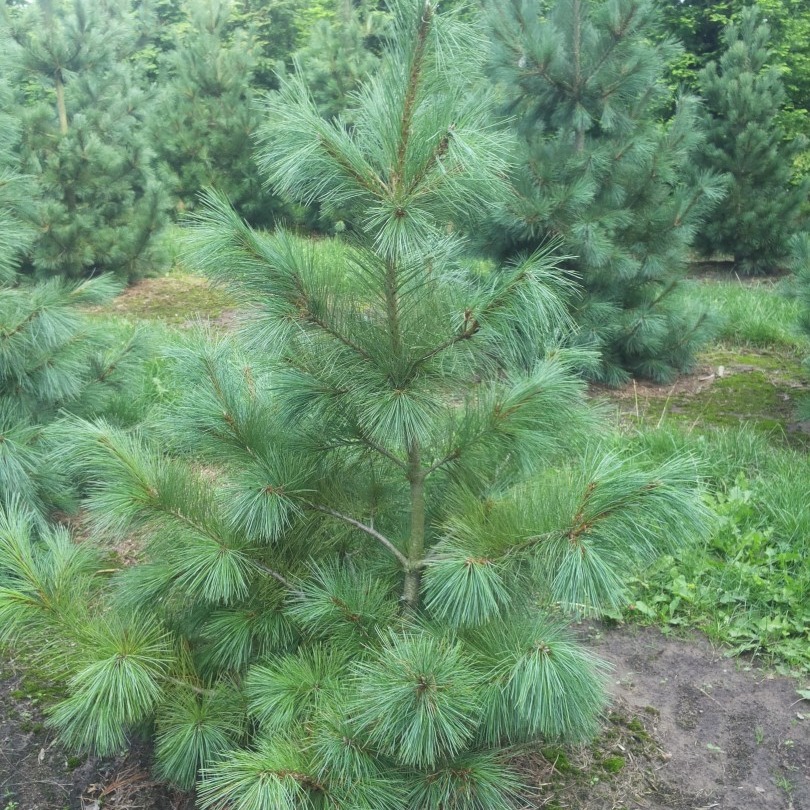
Eastern White Pine is a majestic native evergreen that serves as the tallest conifer in the region, reaching 50-80 feet in typical conditions but capable of growing over 200 feet in ideal environments. This long-lived tree features distinctive bundles of five fine, feathery needles and develops from a pyramidal shape into a more picturesque, irregular form with age. Its open canopy structure provides excellent light filtering while maintaining year-round interest.
As an important component of native forest ecosystems, Eastern White Pine offers significant ecological value by providing food and shelter for birds, small mammals, and various wildlife species. The tree produces distinctive cylindrical brown cones up to 8 inches long that remain on the tree for two years before dropping. The tree thrives in well-drained conditions and prefers full sun exposure, making it an excellent choice for larger landscapes where its impressive stature can be fully appreciated.
- Hardiness: Zones 3-7
- Light: Full sun (6+ hours daily), tolerates partial shade (4-6 hours daily)
- Water: Moderate moisture, drought tolerant once established
- Soil: Well-drained, acidic soils preferred; tolerates various soil types from sandy to heavy textured and alkaline conditions
- Fertilizer: Low maintenance, typically does not require supplemental fertilization
- Pest/Disease Resistance: Generally resistant but can be affected by white pine weevil and blister rust
- Growth Rate: Moderate to fast, slower in early years as seedlings
Sugar Maple (Acer Saccharum)
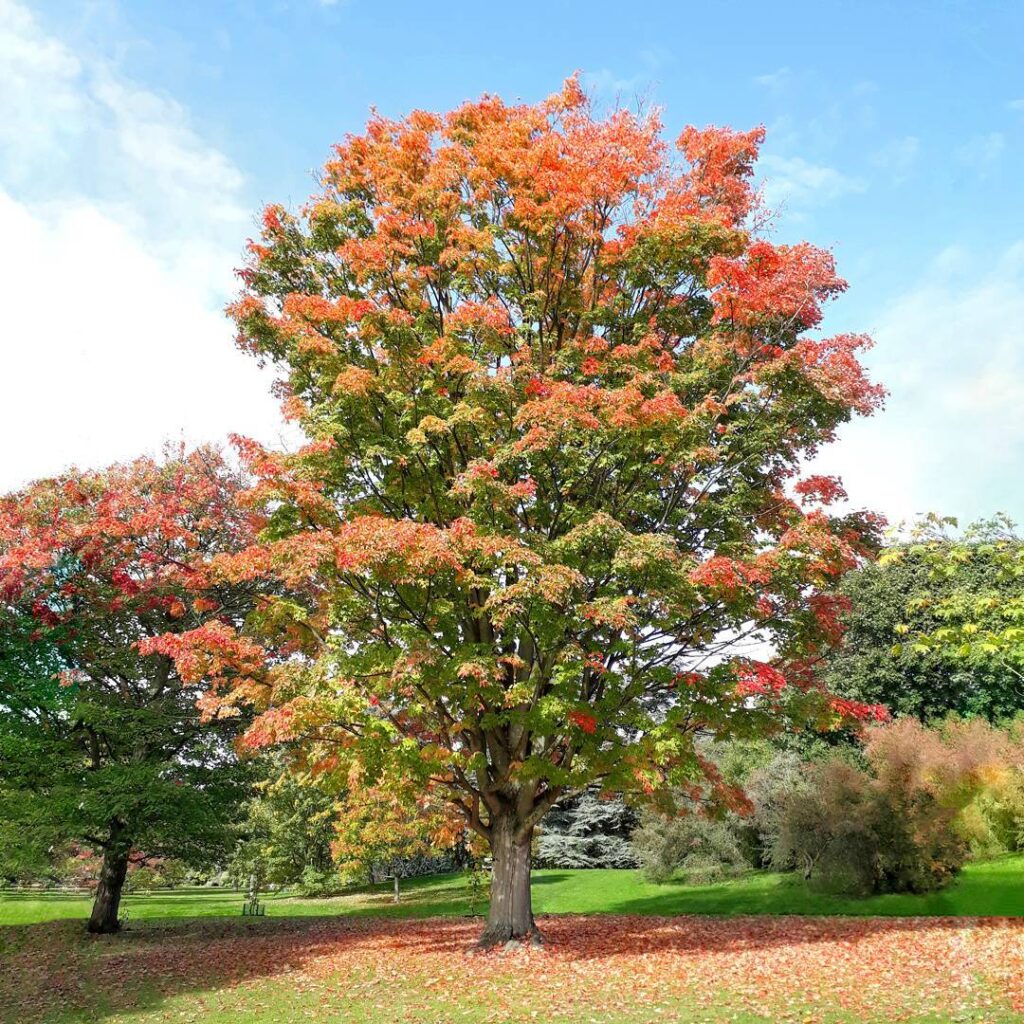
Sugar maple is a magnificent native canopy tree that serves as a cornerstone species in northern New Jersey’s hardwood forests. This large deciduous tree can reach heights of 80-115 feet with a broad, spreading crown that provides exceptional shade. Known for its spectacular fall foliage displaying brilliant yellows, oranges, and red-oranges, sugar maple is equally valued for its ecological importance and commercial uses, particularly as the primary source of maple syrup in North America.
As a climax species, sugar maple plays an essential role in forest succession and biodiversity. Its high shade tolerance as a seedling allows it to persist in mature forests until canopy openings become available. The tree supports various wildlife through its leaves and seeds while contributing to soil stabilization and nutrient cycling. With lifespans of 200-300 years, sugar maples create lasting forest structure and provide dense canopy cover that creates valuable microhabitats for understory plants and forest wildlife. Sugar maples exhibit hydraulic lift, which allows them to influence water content in surrounding soil and benefit nearby plants by redistributing moisture from deeper soil layers to drier surface areas.
- Hardiness: Zones 3-8, well-adapted to northern New Jersey’s climate
- Light: Full sun to part shade, tolerates shade as seedling
- Water: Moderate, consistent moisture; drought sensitive
- Soil: Well-drained, fertile, slightly acidic to neutral; prefers limestone or slightly alkaline soils
- Fertilizer: Generally not needed in forest settings; benefits from organic matter
- Pest/Disease Resistance: Vulnerable to Asian longhorned beetle, leaf scorch, and urban stressors
- Growth Rate: Slow to medium, faster in open areas than dense forests
Red Oak (Quercus Rubra)

Red Oak (Quercus rubra) is a majestic native canopy tree well-suited to northern New Jersey’s climate. This fast-growing oak species can reach 60-75 feet in height and width, forming a broad, rounded crown that provides excellent shade. Distinguished by its shiny bark striping and leaves that emerge pinkish-red before turning dark green and brilliant red in autumn, Red Oak is both ornamental and ecologically valuable.
The species serves as a cornerstone of local ecosystems, supporting numerous wildlife species through its acorn production and serving as a larval host for various butterflies and moths. Its tolerance to urban stresses like pollution and road salt, combined with its ability to thrive in various soil conditions, makes it an excellent choice for parks, large residential properties, and urban forestry projects throughout the region. Red Oak demonstrates exceptional salt tolerance, making it particularly valuable for roadside plantings and coastal areas.
- Hardiness: USDA Zones 3-7
- Light: Full sun to partial shade
- Water: Moderate; drought tolerant once established
- Soil: Well-drained, acidic to neutral pH preferred; tolerates clay and some alkaline conditions
- Fertilizer: Low maintenance; benefits from occasional organic matter
- Pest/Disease Resistance: Good resilience; may experience occasional defoliation from gypsy moths
- Growth Rate: Fast for an oak; 5-6 feet per year under ideal conditions
American Beech (Fagus Grandifolia)
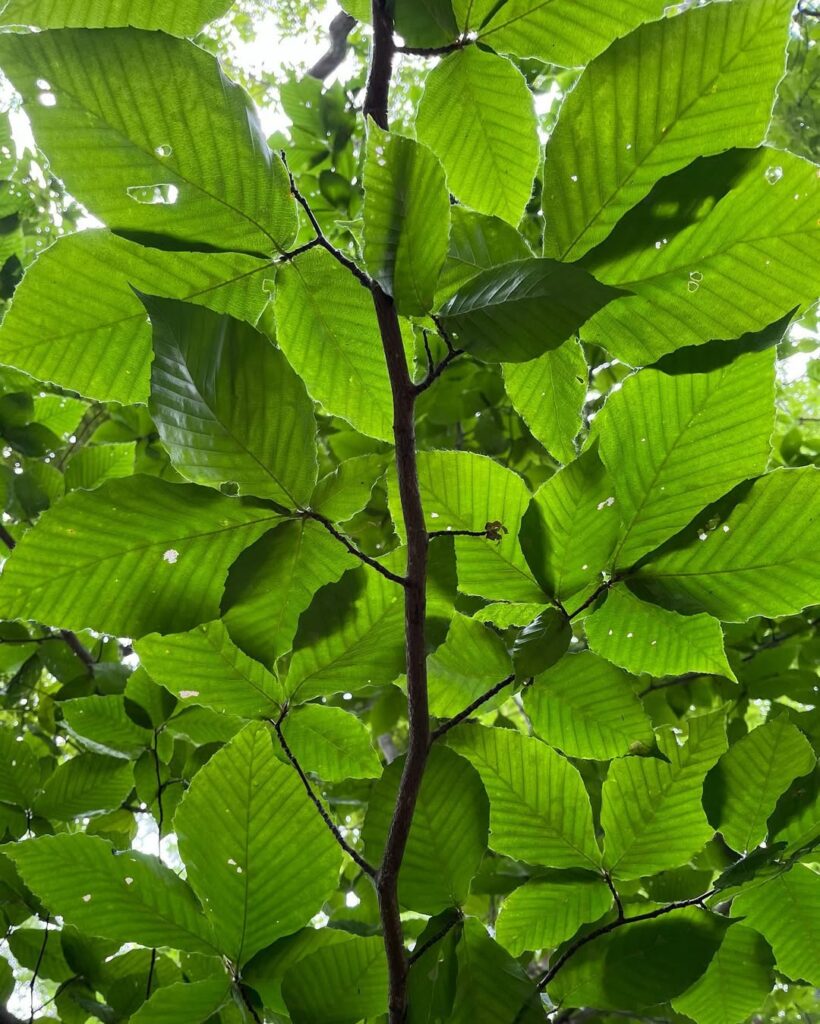
American Beech (Fagus grandifolia) is a magnificent native deciduous tree distinguished by its smooth, gray bark that remains unbroken throughout its potentially 300-year lifespan. This impressive canopy species produces small triangular nuts in spiny husks and can reach substantial sizes in favorable conditions.
As a shade-tolerant species, American Beech thrives in the final stages of forest succession, often forming climax communities with sugar maple. While it has a reputation for slow growth, rich soils and adequate moisture can greatly accelerate development, making it a valuable long-term addition to northern New Jersey landscapes. The tree’s distinctive golden bronze fall foliage often persists well into winter, extending its seasonal interest.
- Hardiness: Zones 3-9, native to eastern North America from Nova Scotia to northern Florida
- Light: Full shade to partial shade; extremely shade tolerant
- Water: High moisture requirements; prefers consistently moist conditions
- Soil: Moist, well-drained, acidic soils; thrives in rich bottomlands and slopes
- Fertilizer: Low requirements in native forest settings with rich organic soil
- Pest/Disease Resistance: Generally hardy but intolerant of urban pollution, salt, and soil compaction
- Growth Rate: Slow (approximately 13 feet in 20 years), faster with ideal moisture and soil conditions
Black Cherry (Prunus Serotina)

Black Cherry (Prunus serotina) is the largest native cherry species in eastern North America, reaching 50-100 feet at maturity. This fast-growing pioneer species thrives throughout northern New Jersey’s diverse habitats, from open woodlands to disturbed sites. In spring, it produces elongated clusters of small white flowers followed by dark berries that provide vital wildlife food. The tree offers significant ecological value as a larval host for numerous moths and butterflies while supplying the only commercially valuable cherry wood in North America, prized for furniture and cabinetry. The fruit is consumed by 33 species of birds and many mammals, making it exceptionally valuable for wildlife habitat.
- Hardiness: USDA zones 3-9, extremely cold tolerant and adaptable to varying climates
- Light: Full sun required for ideal growth and fruit production
- Water: Moderate moisture needs, tolerates both moist and dry conditions once established
- Soil: Adaptable to various soil types, prefers well-drained soils high in organic matter
- Fertilizer: Low maintenance, typically does not require supplemental fertilization
- Pest/Disease Resistance: Susceptible to eastern tent caterpillars and fungal diseases when stressed
- Growth Rate: Fast-growing with early successional tendencies, quickly establishes in open areas
Native Understory Shrubs
Northern New Jersey’s native understory shrubs create essential wildlife habitat while requiring minimal maintenance. Key species include versatile Viburnum varieties, berry-producing Vaccinium family members, and adaptable Holly species with strategic planting considerations. These shrubs provide excellent options for deer-resistant landscaping while supporting local ecosystems.
Spicebush (Lindera Benzoin)
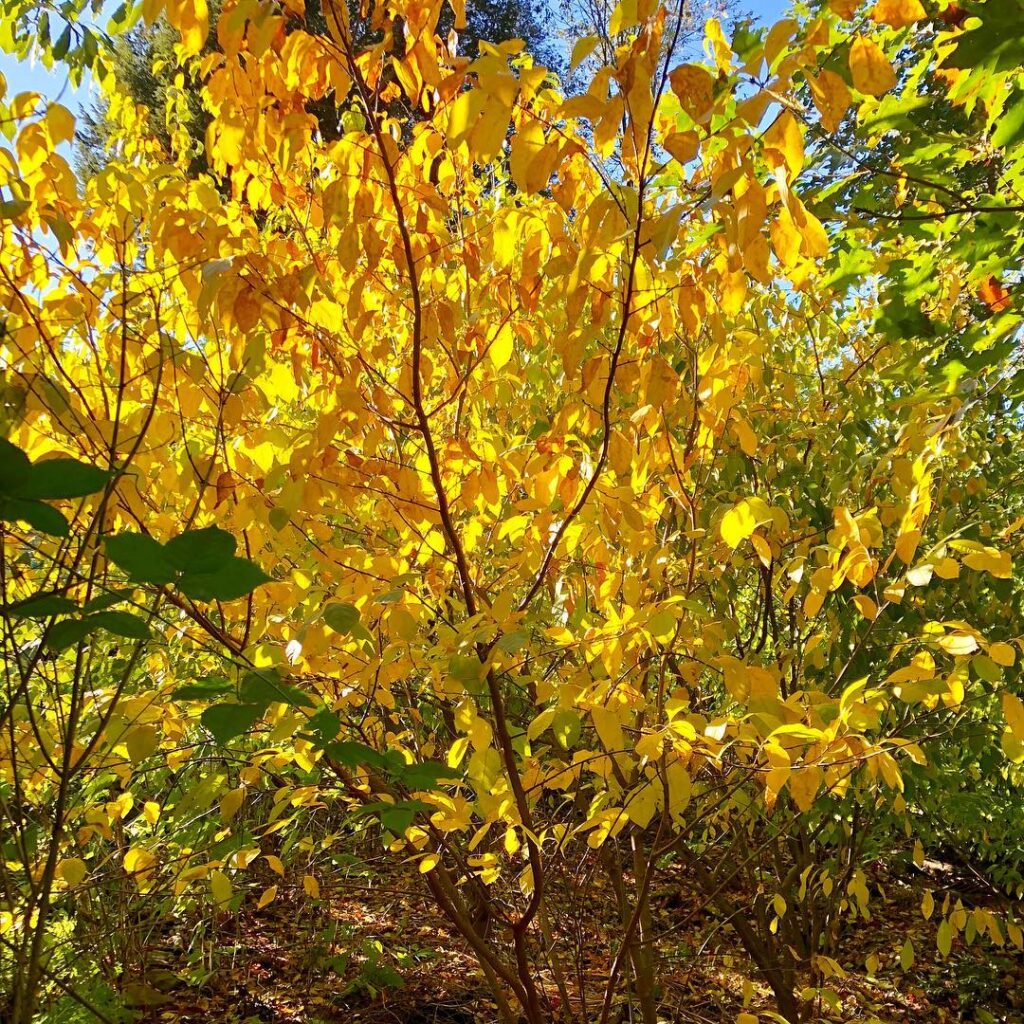
Spicebush (Lindera benzoin) is an aromatic deciduous shrub native to eastern North America, reaching 1-3 meters tall. This understory plant produces small yellow flowers in early spring before leafing out, followed by bright red drupes on female plants that ripen from July to October. The leaves emit a spicy, citrusy fragrance when crushed and turn brilliant yellow in fall.
An excellent choice for naturalized landscapes, spicebush serves as a vital host plant for the spicebush swallowtail butterfly and provides high-energy fruits for wildlife. Historically valued by Native Americans for culinary and medicinal uses, it remains popular in wildlife gardens and shady borders. This low-maintenance shrub spreads by root sprouts and can form attractive thickets in suitable conditions. The aromatic leaves and twigs can be brewed to make a flavorful herbal tea.
- Hardiness: USDA zones 4-9
- Light: Partial shade to full shade; tolerates full sun
- Water: Moist conditions preferred; tolerates wet to moderately dry soils
- Soil: Well-drained, rich woodland soils; adaptable to various soil types
- Fertilizer: None required; thrives in naturally fertile soils
- Pest/Disease Resistance: Excellent; minimal problems
- Growth Rate: Fast-growing
Elderberry (Sambucus Canadensis)
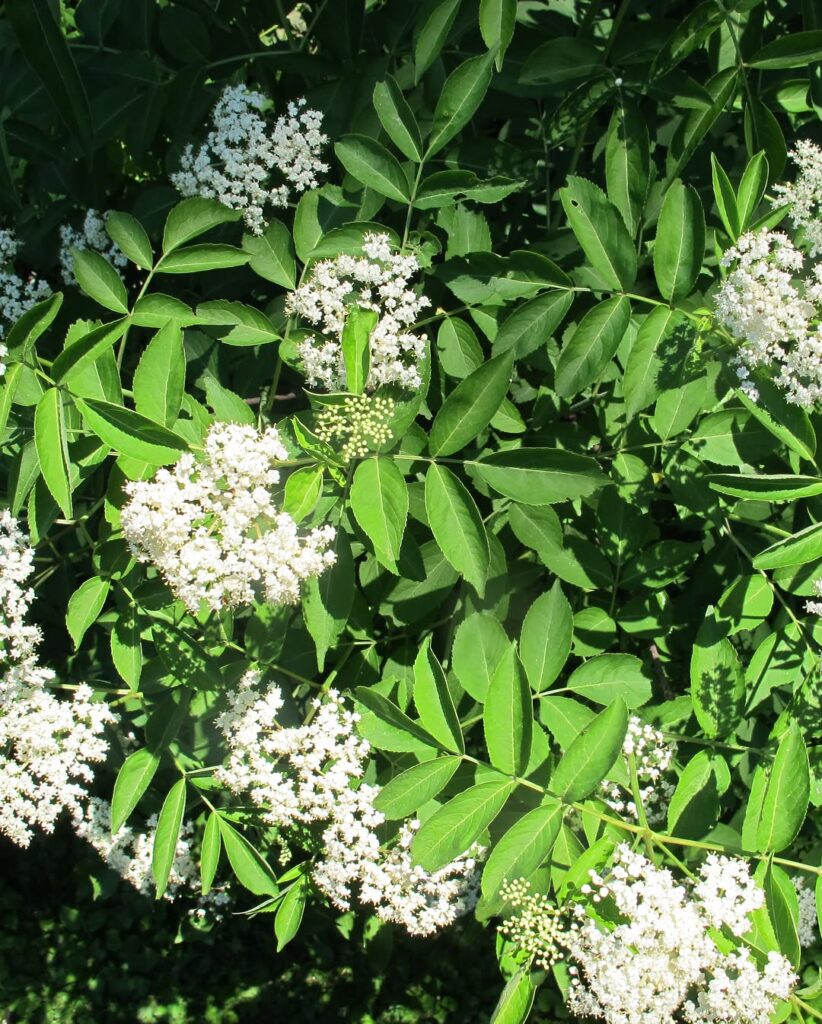
Elderberry (Sambucus canadensis) is a deciduous native shrub that typically grows 5-12 feet tall and wide, making it an excellent choice for naturalized landscapes in northern New Jersey. This adaptable understory plant produces showy white flower clusters from May to September, followed by dark purple-black berries that ripen from July to October. The shrub spreads by root suckers to form dense colonies, making it valuable for erosion control and wildlife habitat.
Beyond its ornamental appeal, elderberry provides exceptional ecological value, attracting over 48 bird species and numerous pollinators. The aromatic flowers and nutritious berries have traditional culinary and medicinal uses, while the plant’s ability to thrive in various conditions makes it ideal for restoration projects along streambanks and in disturbed areas. The compound leaves feature 5 to 11 leaflets with sharply serrated margins, making identification easier for gardeners and naturalists.
- Hardiness: USDA Zones 3-9, well-suited for northern New Jersey climate
- Light: Full sun to partial shade; prefers sunny locations for best flowering and fruiting
- Water: Moderate to high moisture; tolerates both wet and dry sites but prefers consistently moist conditions
- Soil: Adaptable to various soil types; prefers moist, well-drained soils but tolerates seasonal flooding
- Fertilizer: Low maintenance; typically doesn’t require supplemental fertilization in average soils
- Pest/Disease Resistance: Generally resistant to most pests and diseases; tolerates deer pressure well
- Growth Rate: Fast-growing; spreads readily by root suckers to form thickets
Serviceberry (Amelanchier Canadensis)
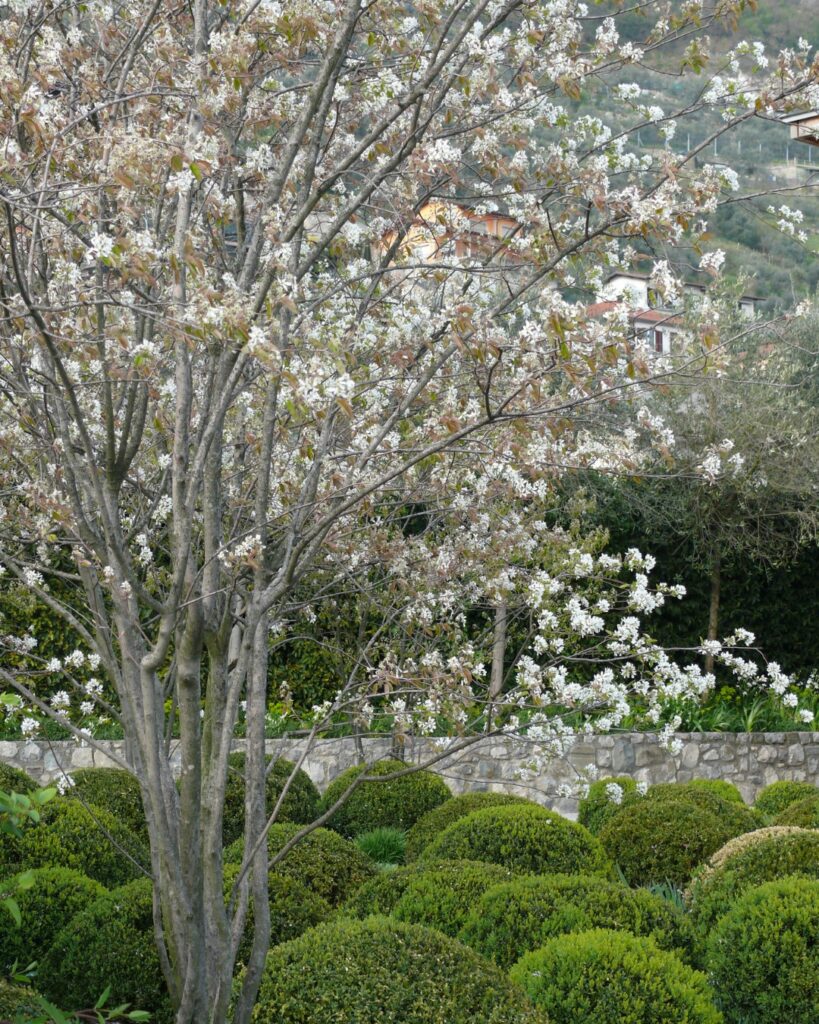
Serviceberry (Amelanchier canadensis) is an exceptional native understory shrub for Northern New Jersey gardens, offering four-season interest with delicate white spring flowers, sweet edible berries, and brilliant fall colors ranging from orange to rusty-red. This multi-stemmed deciduous shrub typically grows 15-25 feet tall and wide, featuring smooth gray bark and an attractive natural form.
Also known as Shadbush due to its spring blooming coinciding with shad fish migration, this versatile native thrives in various conditions from full sun to partial shade. The crimson fruits attract birds and pollinators, while the plant shows good deer resistance, making it valuable for both wildlife habitat and landscape applications across New Jersey’s diverse ecoregions. Seeds require cold-moist stratification for 90-120 days, making fall sowing of fresh, cleaned seeds the most successful propagation method.
- Hardiness: Zones 6a-7b
- Light: Full sun to partial shade
- Water: Moist, well-drained conditions; tolerates wet sites
- Soil: Acidic soils (pH 5.5-7.5); adapts to loam, organic, sandy, clay, and sand textures
- Fertilizer: Low maintenance; benefits from organic matter
- Pest/Disease Resistance: Generally resistant; may experience minor cosmetic issues
- Growth Rate: Medium; spreads by root suckering
Witch Hazel (Hamamelis Virginiana)
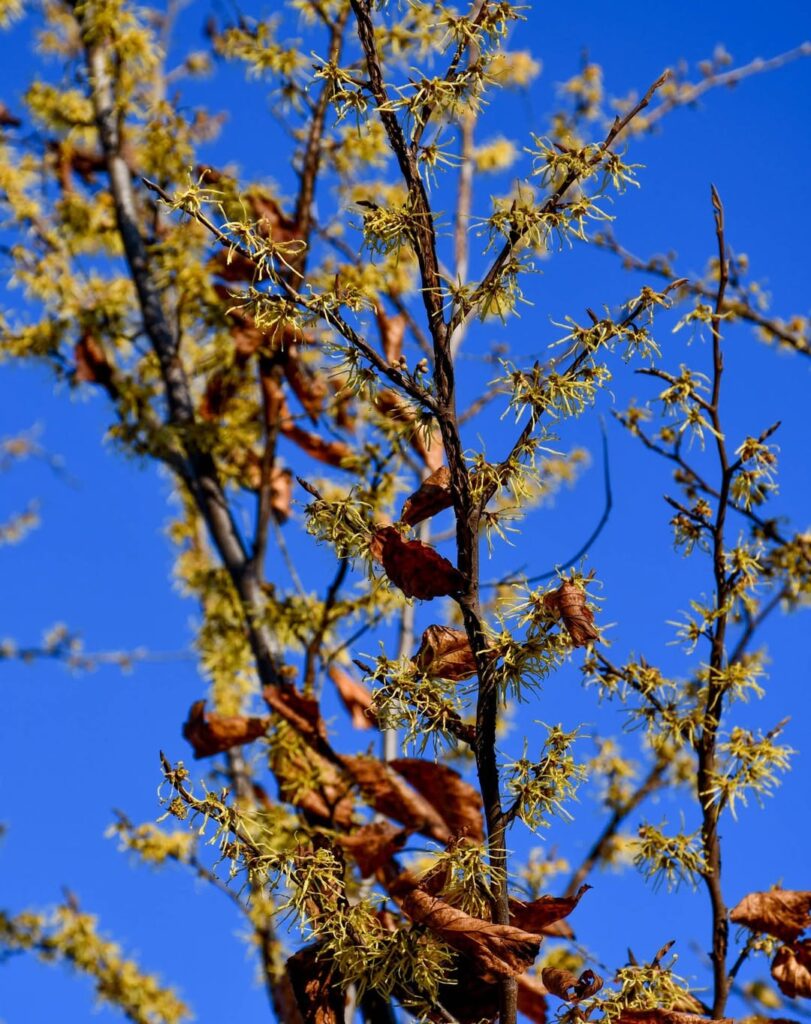
Witch Hazel is a remarkable native shrub that brings unique beauty to Northern New Jersey landscapes through its distinctive late-season blooming period. This versatile plant produces fragrant, fringed yellow flowers from September through November, often blooming after leaves have dropped, creating stunning winter interest when most other plants are dormant.
Growing 12-15 feet tall with an irregular, vase-shaped crown, Witch Hazel adapts exceptionally well to various garden conditions. Its multi-stemmed trunk and arching branches create an attractive architectural form, while the rounded leaves provide excellent fall color before giving way to the plant’s signature winter blooms. This native species supports local wildlife, serving as a host plant for specialized moths and providing fruit for birds. Beyond its ornamental value, Witch Hazel has practical applications as commercial witch hazel is derived from its bark and used as an astringent liniment.
- Hardiness: USDA zones 3-8
- Light: Full sun to shade (fuller form in full sun)
- Water: Dry to moist conditions, tolerates wet soils
- Soil: Adaptable to clay, loam, sand, and poor soils
- Fertilizer: Low requirements, thrives without supplemental feeding
- Pest/Disease Resistance: Excellent, very few serious issues
- Growth Rate: Slow to moderate
Viburnum Nudum (Possumhaw Viburnum)
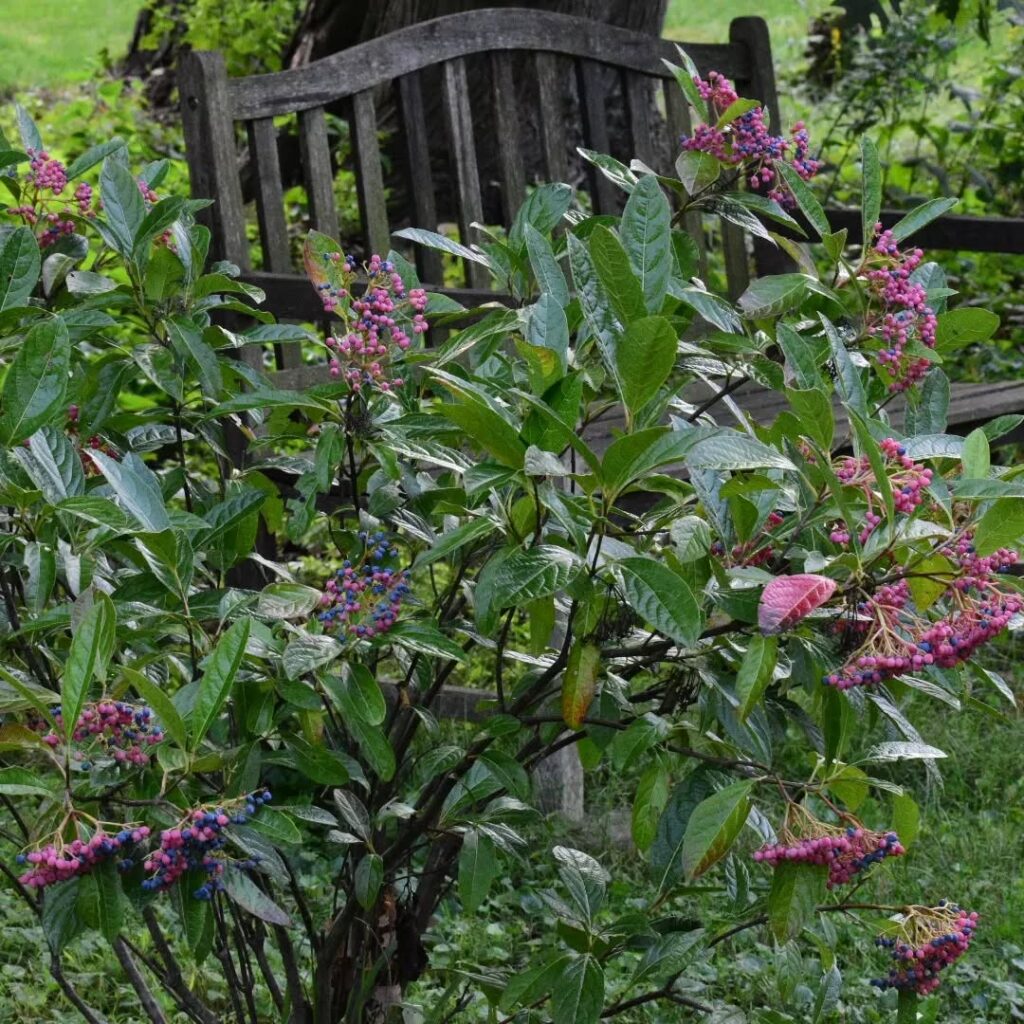
Viburnum Nudum, commonly known as Possumhaw Viburnum, is a versatile native understory shrub that grows 5-12 feet tall and wide with an upright-spreading habit. This deciduous shrub produces showy clusters of white flowers in late spring, followed by colorful berries that shift through various hues as they ripen, providing exceptional wildlife value. The species features notably lustrous foliage that distinguishes it from other viburnum varieties.
The plant offers year-round interest with fragrant spring blooms, summer berries enjoyed by birds and small mammals, and vibrant fall foliage. As a larval host for Spring Azure butterflies and supporter of Hummingbird Clearwing moths, it serves as an excellent choice for pollinator gardens, privacy screens, and rain gardens while contributing greatly to local ecosystem health.
- Hardiness: USDA zones 5-9
- Light: Full sun to part shade
- Water: Medium to wet, consistent moisture preferred
- Soil: Well-drained, adaptable to various soil types
- Fertilizer: Low maintenance, minimal fertilization needed
- Pest/Disease Resistance: Good resistance to common pests and diseases
- Growth Rate: Moderate
Selecting the Right Native Plants for Your Garden
When you’re choosing native plants for your Northern New Jersey garden, success depends on matching the right species to your specific site conditions and goals. Start by evaluating sunlight exposure, moisture levels, and your garden’s purpose. Soil testing reveals pH levels and nutrient content, helping you select compatible natives.
Visit local hiking trails to observe which species thrive naturally together, as plant compatibility in nature translates to garden success. Group plants with similar water requirements to create efficient irrigation zones. Consider whether you’re attracting pollinators, conserving water, or creating wildlife habitat, then choose diverse natives that support your objectives. Regular monitoring of plant health throughout the growing season ensures your native garden continues to flourish as plants establish themselves.
Frequently Asked Questions
When Is the Best Time to Plant Native Species in Northern New Jersey?
You’ll find ideal planting times for native species in northern New Jersey are fall and early spring. These seasons align with natural seasonal growth patterns, reducing transplant shock while promoting strong root establishment.
How Do I Control Invasive Species That Compete With My Native Plants?
You’ll prevent, detect, and remove invasive species through consistent monitoring and early intervention. Effective invasive species management includes hand-pulling seedlings, cutting established plants, and replanting with natives to maximize native plant benefits.
What Native Plants Attract Butterflies and Hummingbirds to My Garden?
You’ll attract butterflies with native milkweeds, asters, and butterfly weed instead of non-native butterfly bushes. For hummingbirds, plant native bee balm and cardinal flower rather than relying solely on hummingbird feeders for consistent wildlife support.
Do Native Plants Require Fertilizer or Can They Grow Without Amendments?
Like well-adapted athletes, native plants thrive without fertilizer supplements. You’ll discover native plant benefits include naturally accessing soil nutrients through deep roots and mycorrhizae partnerships, maintaining excellent soil health without amendments.
Where Can I Purchase Native Plants and Seeds in Northern New Jersey?
You’ll find native plants at local nurseries like Goffle Brook Farm & Garden Center in Ridgewood or through online retailers such as Wild Ridge Plants and Toadshade Wildflower Farm for convenient delivery.
